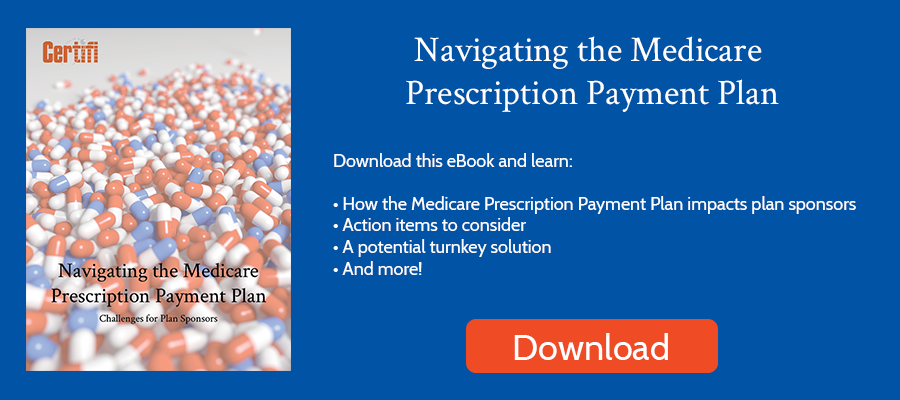The Inflation Reduction Act enabled Medicare Part D enrollees to pay their out-of-pocket prescription costs monthly, helping spread those costs throughout the year. In the summer of 2023, the Centers for Medicare and Medicaid Services (CMS) released draft guidance to help further elucidate requirements for what’s come to be known as the Medicare Prescription Payment Plan.
As many plan sponsors dug into the requirements, they likely discovered that their current solution may be inadequate for managing the monthly billing outlined in the draft guidance. As a result, they may be shopping for a billing solution to address those shortcomings.
Here are five Medicare Prescription Payment Plan billing software features those plan sponsors should seek to simplify compliance:
Configurable Billing Rules
The biggest hurdle for many health plans may be the complicated monthly billing structure outlined in the draft guidance. It’s likely not comparable to existing billing processes because it uses monthly caps – calculated in the first and subsequent months – to determine monthly billing amounts.
For the first month, the calculation is:
First Month Cap = (Annual Out-of-Pocket Threshold – Incurred Participant Costs)/ Number of Months Remaining in Plan Year
For subsequent months, the calculation is:
Monthly Cap = (Sum of Remaining Unbilled Out-of-Pocket Costs +Additional Incurred Out-of-Pocket Costs)/Number of Months Remaining in Plan Year
For 2025, the out-of-pocket cap is $2,000.
Because internally developed billing systems or core admin billing modules likely don’t have much billing rule flexibility, if you’re shopping for a billing solution to manage the Medicare Prescription Payment Plan, prioritize flexible solutions that enable configurable – not coded – billing rules. Should future Medicare Prescription Payment Plan guidance require modifications to the billing rules – and they likely will as the out-of-pocket cap will change – having a configurable solution simplifies modifying billing rules to meet plan changes.
Integrated, Configurable Delinquency Management
The Medicare Prescription Payment Plan guidance includes well-defined delinquency notification requirements. The draft guidance requires two notice requirements:
- Initial delinquency notice: Plan sponsors must send this communication within 15 days of the payment due date. It includes specific data, like termination details, the billed amount, and how to pay.
- Termination Notice: Sponsors must send termination notices within three days after the end of the grace period. This notice also includes defined information, like how the plan sponsor will collect the outstanding balance, the dispute process, and that the plan sponsor terminated the participant from the Medicare Prescription Payment Plan but not the Part D plan.
For plan sponsors who don’t have delinquency processes in place today or whose processes are manual – involving data extracts and mail merges – delinquency requirements could add significant labor costs.
The solution? Look for billing software – like Certifi’s – that includes integrated, automated delinquency management. By configuring notifications to meet Medicare Prescription Payment Plan requirements, setting delinquency rules (like when to generate notices), and then creating and distributing those invoices by print and email, you’ll save time while ensuring you’re meeting Medicare Prescription Payment Plan requirements.
Configurable Invoices
The Medicare Prescription Payment Plan draft guidance details information that plans must include on each monthly premium bill. That includes what the bill is for, the effective date of program participation, the date, amount, and means of last payment made, previous balance, itemized out-of-pocket costs, and more.
As you can see, there are unique data elements that you may not use elsewhere. The ability to configure invoices to meet those requirements is vital. Whether that means dropping unique data elements – like the program’s effective date or the last payment type – or specific text – like low-income subsidy program information or how to opt out of the program – quickly configuring invoice content simplifies compliance with current and future Medicare Prescription Payment Plan guidance.
Supports Multiple Payment Types
Though the draft guidance doesn’t require specific payment types, it does recommend multiple payment options. The guidance mentioned considering cash payment as an option, intending to make it easy for beneficiaries to pay.
Search for a software solution that enables multiple payment types – including cash. For example, Certifi’s solution includes a retail cash payment network of national retail locations. Beneficiaries need only take their invoice to the location, have the clerk scan the barcode, and pay.
The software should also enable check and card payments. Integrating with your bank’s lockbox facilitates electronic payment data delivery for check payments, improving and automating payment reconciliation. If the solution provider has a preferred payment processor, it will streamline the setup of card transactions.
Integrated Payment Portal
The Medicare Prescription Payment Plan will go live in less than a year. With all the requirements outlined above to manage, the last thing you want to do is connect a new software solution to your existing payment portal. Or worse, stand up or go without a payment portal.
Instead, look for a billing software solution that includes a payment portal so you can manage the billing process from end to end in a single platform. We wrote about attributes of a premium billing payment portal in the past, and they all apply to the Medicare Prescription Payment Plan, including:
- Mobile friendly
- Enable recurring payment setup
- Single sign-on
- Invoice presentment
- Billing and payment history
- Payment options
- Appropriate branding
Conclusion
While navigating the complexities of the Medicare Prescription Payment Plan may seem daunting, choosing the right billing software can drastically simplify compliance and streamline your workflows. By prioritizing configurable billing rules, integrated delinquency management, customizable invoices, multiple payment options, and a built-in payment portal, you can easily handle the Medicare Prescription Payment Plan, ensuring your beneficiaries have a smooth experience.
Certifi’s Medicare Prescription Payment Plan billing and payment solutions help Part D plan sponsors and PBMs save time and improve M3P billing accuracy.



